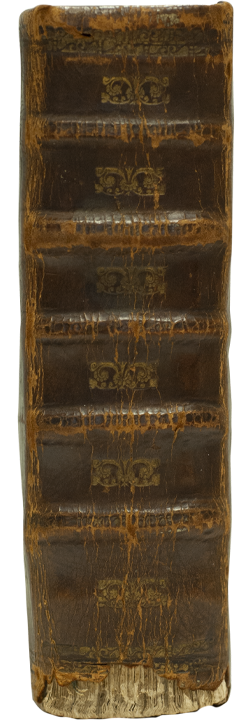About

Welcome to Impressions: a blog dedicated to the Special Collections at Huron and Western University in London, Ontario. Impressions comes with multiple meanings, including, not least, the traces that type makes when it bites into paper during letterpress printing. To impress, in this sense, is a physical act. But the sight and feel of a rare book can also make an impression that is both tactile and cognitive. Indeed, my blogging about rare books is an attempt to impress on others the rich materiality of the books I study. After five years of working closely with the Special Collections at Huron and Western, and often sharing my finds with local colleagues and students in the classroom, it is now time to disseminate my thoughts and findings with a larger audience.
In working with rare books, one discovers quickly the idiosyncratic nature of each copy. Indeed, the label “copy-specific” is often employed to demark the unique material differences found from copy to copy. One copy of a seventeenth-century book may come bound in an early calf binding, while another will be bound in limp vellum. One copy may have no evidence of past ownership, while another is littered with signatures and bookplates. And while one copy of a book may be “clean”, another may be smothered in notes, diagrams and other readers’ marks. Impressions places particular emphasis on the “copy-specific” features of rare books, both the bibliographical variants that surface from the printing of a particular imprint and the post-print additions found in individual copies of a book.
How we display such features online matters. Over the last two decades we have witnessed a mass digitization of early printed books through important initiatives such as Early English Books Online (EEBO), Internet Archive, and the HathiTrust, and while such initiatives provide easy access to older books, they can also present a kind of illusion. Large-scale digitization may provide us with an extensive record of printed content, but it also comes without the rich materiality of the book. Size, texture and colour are often sacrificed in the name of scale and search. But not all digital projects are alike. In fact, many recent initiatives are dedicated to producing high quality colour images of books that can be magnified and studied in detail. One thinks, for instance, of the many digital projects at the Folger Shakespeare Library. Specialized sites focusing on ownership and binding, for example, offer healthy approaches to breaking up books for comparative research, while important initiatives such as ArchBook: Architectures of the Book similarly engage with key features of the book as traced in the long history of manuscript, print, and more recently, electronic and digital settings. What these initiatives offer is not simply a more specialized approach to Book History, but a recognition of the importance of design and craft in how we display the book in digital space.
As with most digital projects, Impressions is collaborative. Huron’s Digital Scholarship Librarian, Ryan Rabie, is an essential contributor to the project as he has assisted with photography, page design and many improvements. I am grateful for his willingness to assist with the project and for Huron Library’s generous support to host the site.
A Few final points on logistics:
1. Timing: My goal is to provide one lengthy, image-rich post as often as time allows. While I have started with an early modern English book, I will be moving to other periods and places in subsequent posts. The goal is to showcase the rich breadth of materials at my local institutions.
2. Scope: Each post will focus on a particular imprint and/or manuscript, looking at how it was produced and by whom, while also considering evidence of reading and ownership. Some posts will dig deep into the bibliographical trenches, looking at variants and other finer points of print production, while other posts will focus on broader issues in readership and publishing and the larger social and political issues at stake.
3. Additions and Amendations: One of the beautiful things about working in digital environments is that you can make changes fairly easily. In the event I need to revise a point, add to a post, or incorporate new thoughts from a comment, I will do so. All changes will be noted in dark grey font and they will be dated.
4. References and Resources
(a) All posts will include cross-references to bibliographies and other listings that record the work under discussion. For the first post that includes the STC, the ESTC and EEBO. In addition to bibliographic resources, I will draw on no less than three secondary sources for each post.
(b) All posts are part of Huron University College’s WordPress site. All photography is done using a Nikon D70 and Nikon D7500 with a variety of lenses: AF Micro-Nikkor 60mm f/2.8D, AF-S Nikkor 105mm f/2.8G ED Micro VRII, and AF-S Nikkor 50mm f/1.8G. All digital editing is conducted through Adobe Photoshop.
5. Access. Those interested in working with Huron’s Rare Books should make an appointment with the Director of Library and Learning Services, Dr. Rachel Melis. For details on Western’s Special Collections , see https://www.lib.uwo.ca/archives/

 Scott Schofield is the author behind Impressions. He is an Associate Professor in the Department of English and Cultural Studies at Huron University College. An Early Modern scholar, with expertise in Book History and the Digital Humanities, his research focuses heavily on the history of printing, reading and collecting of books.
Scott Schofield is the author behind Impressions. He is an Associate Professor in the Department of English and Cultural Studies at Huron University College. An Early Modern scholar, with expertise in Book History and the Digital Humanities, his research focuses heavily on the history of printing, reading and collecting of books.
 Ryan Rabie is responsible for the photography, layout, and design of Impressions. He is the Digital Scholarship Librarian at Huron Library. He has a focus on digital publishing and scholarship, use of technology in teaching and learning, and the importance of visual design in higher education.
Ryan Rabie is responsible for the photography, layout, and design of Impressions. He is the Digital Scholarship Librarian at Huron Library. He has a focus on digital publishing and scholarship, use of technology in teaching and learning, and the importance of visual design in higher education.